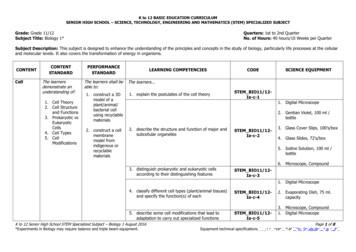S A F E Transport, Storage, And Disposal Of Pesticides
EC2507(Revised October 2019)S A F E Transport,Storage, andDisposal ofPesticidesClyde L. Ogg, Extension EducatorJan R. Hygnstrom, Project ManagerErin C. Bauer, Entomology LecturerFrank J. Bright, Extension AssistantExtension is a Division of the Institute of Agriculture and Natural Resources at theUniversity of Nebraska–Lincoln cooperatingwith the Counties and the United States Department of Agriculture.University of Nebraska–Lincoln Extension educational programs abide with thenondiscrimination policies of the University of Nebraska–Lincoln and the UnitedStates Department of Agriculture. 2001-2008, 2013, 2019 The Board of Regents of the University of Nebraska onbehalf of the University of Nebraska–Lincoln Extension. All rights reserved.
Most accidental pesticide poisoningsoccur when pesticides are mishandled.Young children are often the victims.Pesticide accidents can be prevented by careful planning, using a secure storage location, adopting safehandling methods during transport, and followingproper disposal guidelines for both products andcontainers.The first step in preventing accidental poisoningsand environmental contamination is to use goodjudgment when buying pesticides. Buy only the amount that can be used in a reasonable length of time. Don’t be tempted by “sale prices.” Buy pesticides in quantities that you will use inthe near future. Some pesticides should not be storedfor long periods of time, allowed to freeze, or bestored in direct sunlight because they may becomeless effective.Always keep pesticides in their original containers. Using any other container is illegal and couldcause an accidental pesticide poisoning. Also, using another container could make it very difficult toretrieve the pesticide label information in the case ofpesticide poisoning or environmental contamination.2 The Board of Regents of the University of Nebraska. All rights reserved.
Transporting PesticidesCertain precautions should be taken whentransporting pesticides. Traffic accidentscan happen even when you travel only ashort distance, and improperly loaded pesticide containers can become dislodged and damaged. Becausepesticides are transported on public roads, thepotential damage from such accidents is great.Never transport pesticides with food, livestock/poultry feed, or minerals. Also, transport pesticidesseparately from seed, grain, or consumer goods.Keep a pesticide spill kit in your vehicle at alltimes. A spill kit commonly contains chemicalresistant gloves, coveralls, and goggles; sorbent padsand absorbent material (such as kitty litter); shovel;and a plastic temporary storage bag or container.In case of a pesticide spill follow the three “C’s”:control, contain, and cleanup. Control the spillimmediately to prevent further spillage. Turn off orclose the valve on a leaky hose or upright a containerthat has tipped over. Contain the spill. Dike the spillwith absorbent material or sorbent pads to keep itout of water and prevent environmental contamination. Clean up the spill. Use absorbent material tosoak up the spill, then shovel contaminated materialinto a plastic storage container for disposal. Additional information may be found in the shippingpapers or the label.What Vehicle to Usetive clothing and equipment in the passenger compartment of the vehicle. You will need protectiveequipment if a spill or other pesticide-related accident should occur.Thoroughly inspect all containers at the time ofpurchase, before loading. Accept them only if thelabels are legible and firmly attached. Check all caps,plugs, or bungs and tighten them if necessary. Ifleakage has occurred, do not accept the container.Request another container.When loading containers, handle them carefully;don’t toss or drop them. Avoid sliding containersover rough surfaces that could rip bags or puncturerigid containers. Know safe handling procedureswhen using forklifts. Secure all containers to thetruck to prevent load shifts and potenti
preparedness for responding to transportation accidents . Hazmat training includes general aware-ness training, function-specific training, and safety training. DOT Training Is Available. The DOT Office of Hazardous Materials Safety has prepared training modules that meet the requirements for general awareness Hazmat training. These modules are
Transport Management System of Nepal Nepalese transport management is affected by existing topographical condition of the country. Due to this only means of transport used in the country are road transport and air transport. In this paper only road transport is discussed. During the Tenth Plan period, the vehicle transport management
A. Core Transport Management System Forms 149 B. Ghana Transport Policy 173. C. Resources for TMS Stakeholders 183. D. Transport Assessment Tool 185. Figures . 1. A Typical National Transport Management Human Resource Structure 2 . 2. A Typical Health Facility or Provincial/District Office Transport Management Structure 2 . 3. Completed Period .
3. LCA of rail freight transport 4. LCA of IWW transport 5. LCA of road freight transport 6. Comparison of the environmental impacts of the transport modes III. Environmental impact assessment of freight transport 7. Study of intermodal freight transport routes 8. Study of the modal split of inland freight transport in Belgium IV. Conclusions .
Sand transport is herein defined as the transport of particles with sizes in the range of 0.05 to 2 mm as found in the bed of rivers, estuaries and coastal waters. The two main modes of sand transport are bed-load transport and suspended load transport. The bed-load transport is defined to consist of gliding, rolling and saltating particles in
Independent Personal Pronouns Personal Pronouns in Hebrew Person, Gender, Number Singular Person, Gender, Number Plural 3ms (he, it) א ִוה 3mp (they) Sֵה ,הַָּ֫ ֵה 3fs (she, it) א O ה 3fp (they) Uֵה , הַָּ֫ ֵה 2ms (you) הָּ תַא2mp (you all) Sֶּ תַא 2fs (you) ְ תַא 2fp (you
et sur les infrastructures de transport 25 - Transport et activité économique 55 - Entreprises françaises de transport 89 - Emploi et salaires 97 - Les externalités du transport 117 - Le transport de marchandises 129 - Le transport de voyageurs 141 - Bilan de la circulation 149 - Annexes
Transport c. Active Transport d. Bulk/Vesic ular Transport 2. relate the structure and composition of the cell membrane to its function STEM_BIO11/12-Ig-h-12 3. explain transport mechanisms in cells (diffusion osmosis, facilitated transport, active transport) STEM_BIO11
Types of Transport There are 3 types of transport in cells: 1. Passive Transport: does not use the cell’s energy in bringing materials in & out of the cell 2. Active Transport: does use the cell’s energy in bringing materials in & out of the cell 3. Bulk Transport: involves the cell making me























